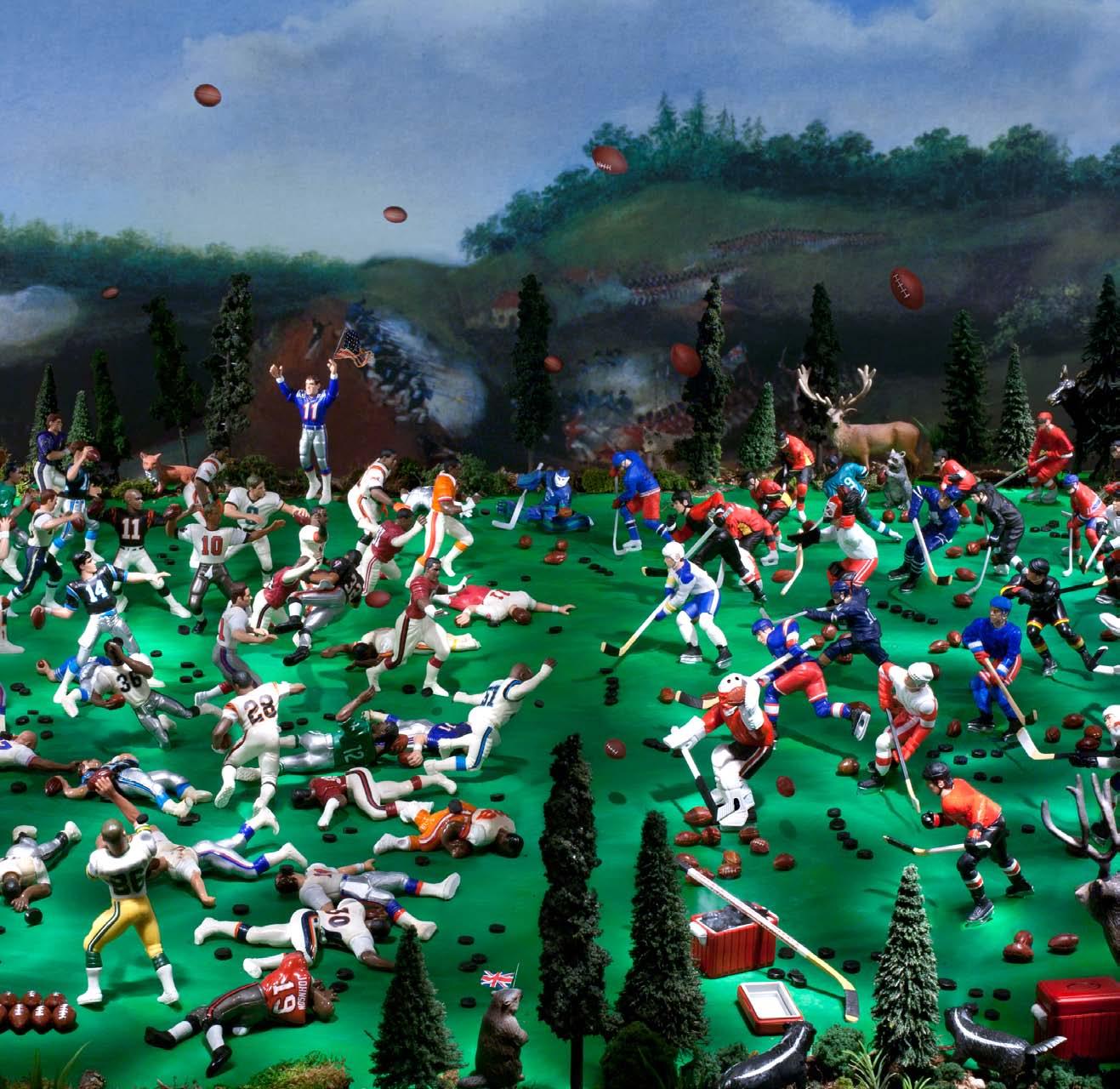DIANA THORNEYCROFT

Canadians and Americans (best friends forever...it’s complicated)


Canadians and Americans (best friends forever...it’s complicated)
Canadians and Americans (best friends forever...it’s complicated)
Essay by Dr. David S. Churchill
Associate Professor, History, University of Manitoba
Michael Gibson Gallery
October 3 - 26, 2013

The Battle of Queenston Heights (War of 1812)
Chromogenic Digital Photograph, 2013
Edition of 5 - 33 1/4 x 50 in / 85 x 127 cm
Edition of 20 - 20 x 30 in / 51 x 76 cm
Dr. David S. Churchill
In 2012 the Government of Canada spent $25 million commemorating the War of 1812, a conflict between the fledgling United States of America, First Nations people and the world’s colonial super power Great Britain. The celebration of this distant conflict, one that took place fifty-five years before Confederation in 1867, is part of Stephen Harper’s Conservative Government’s attempt to reimagine Canada as a warrior nation and the War of 1812 as a nascent moment of national origin. Yet clearly a split consciousness is at work in this act of historical remembrance. While the commemoration supposedly glorifies Canadian independence and martial prowess, it also serves as a reminder that Canada’s direct neighbour, closest ally, largest trading partner, and world’s dominant super power, is also its oldest enemy. Canadians are in a sense the un-Americans, a people with a great deal of shared history born of conflict. Yet it would be hard to find two nation-states in today’s world who share as much in common in terms of culture, commerce, sentiment, language and sensibility. We are the very best of international partners, models of cooperation, strategic interest, and statecraft. The oldest of enemies are also the very best of friends. Awkward n’est-ce pas?
This fraught and ambiguous intimacy is rich terrain for artist Diana Thorneycroft. Her photographs of intricate and exactingly constructed dioramas are rife with these conflicting, contradictory and awkward impulses. Indeed, it is in this ambiguous zone between nation-states – a border that is both a division and a line that is constantly being transgressed – on which Thorneycroft often fixes her aesthetic and critical scrutiny. In fact, Thorneycroft reimagines the War of 1812, particularly The Battle of Queenston Heights (War of 1812), as a fight between sports teams, in this case Cana-
dian hockey versus American football. A fitting reconceptualization, in that sport is so often the displaced site for national rivalries, identity, and chauvinism. So what then does it mean to belong to a place, a time, a culture, and a nation? Thorneycroft is an adept and playful storyteller. Her photographic dioramas touch and poke at popular anxieties of assimilation, cultural imperialism, the mis-recognition of national distinction and the narcissism of minor differences between two remarkably similar English speaking settler-colonial nations. Moreover, in the varied scenes in each of the photographs, Thorneycroft reminds the viewer of the way that consumption, melded with the pervasive fixation on celebrity in contemporary culture, has increasingly squeezed out and displaced older representational forms of national identity. Today it is the banal act of eating doughnuts, shooting guns, drinking beer in stubby bottles (something no longer available) that signifies national belonging and citizenship. No longer are traditional aesthetic expressions – such as painting and fine art – constitutive of national public culture. Group of Seven? Do you mean Group of 7-Eleven?
As with her other recent work, The Canadiana Martyrdom Series (2006) and Group of Seven Awkward Moments (2007-2010), Thorneycroft utilizes dolls, toys and figurines, many purchased off eBay, to build her vignettes. Thorneycroft’s use of light, colour, and figurines evoke the holiday windows of department stores such as Eaton’s and Macy’s. A master of this mise-en-scène, she constructs tableaux filled with child-like wonder and magic that on closer scrutiny are populated with an assemblage of sinister action, menace, irony, and satire.
In each of the dioramas, Thorneycroft employs familiar and recognizable works of art, particularly 19th and 20th century landscape paintings by prominent American and Canadian artists, such as Winslow Homer, Edward Hopper, A.J. Casson, Thomas Eakins, J.E.H. MacDonald, Albert Bierstadt and Andrew Wyeth, among others, to provide a recognizable and familiar setting to each of the works. Populat-
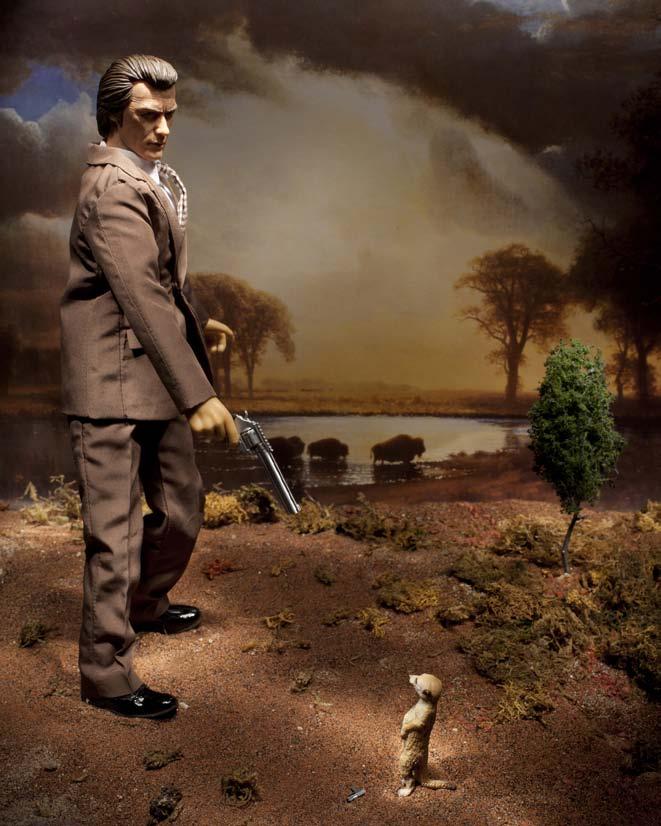
Dirty Harry on the Buffalo Trail (I know what you’re thinking...punk)
Chromogenic Digital Photograph, 2012
Edition of 5 - 50 x 40 in / 127 x 102 cm
Edition of 20 - 30 x 24 in / 76 x 61 cm
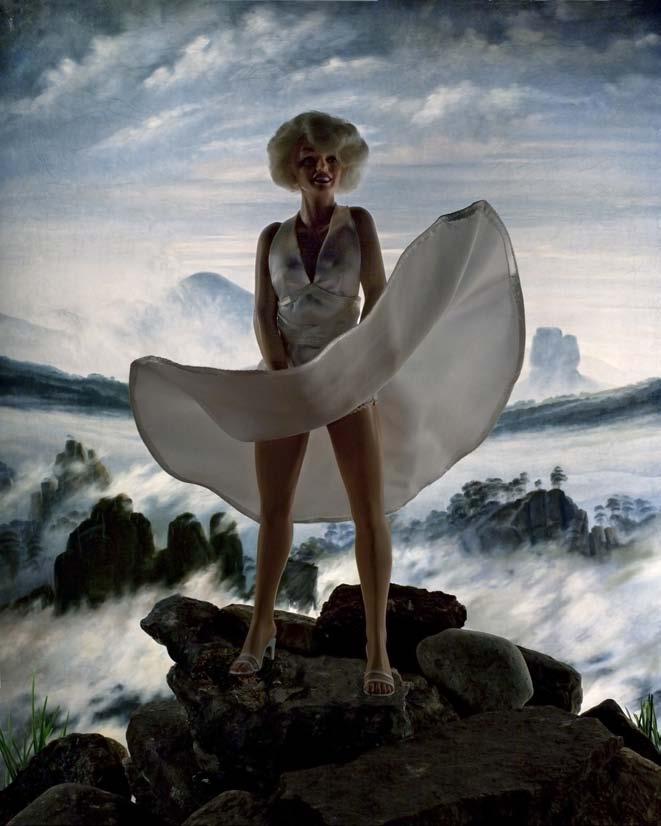
Chromogenic Digital Photograph, 2012
Edition of 5 - 50 x 40 in / 127 x 102 cm
Edition of 20 - 30 x 24 in / 76 x 61 cm
ing these scenarios are action figures and dolls made to resemble movie and television actors depicted in their most celebrated roles. Thus, Clint Eastwood as “Dirty Harry” Callahan, the renegade San Francisco cop, brandishes his .44 Magnum in yet another act of retributive justice; this time against a quizzical and seemingly unarmed meerkat. In depicting the physical asymmetry and disproportionate power between the two figures, Thorneycroft reminds the viewer of the arbitrary strength of US power and authority.
One of the only non-North American art works Thorneycroft employs is her reimagining of German Romantic painter Caspar David Friedrich’s (German 17741840) Wanderer Above the Sea of Fog (1818). Friedrich’s painting of the contemplative individual is a classic work of 19th century Romanticism, an image of human accomplishment and endeavor, juxtaposed against the power and sublime beauty of nature. Thorneycroft deftly inverts Friedrich’s composition, from 19th century masculine circumspection to a 20th century sexualized masculine gaze. By turning the figure toward the viewer, in this case American movie star Marilyn Monroe, Thorneycroft shifts the composition from one of spectator identification to one of objectification. Yet in decontextualizing a familiar image from popular culture, in this case Monroe frozen in a famous scene from the movie The Seven Year Itch (1955), Thorneycroft endeavors to provide her subject with a measure of agency. Monroe, unlike the solitary figure in Friedrich’s painting; who is almost indistinguishable in colour and tone from the jagged rock, is depicted in diaphanous atmospheric white, a figure who in the words of poet John Magee could “slip the surly bonds of earth” and simply float away. Monroe’s cloud-like platinum hair and billowing white dress are extensions of the wind, air and fog, lifting her, it would seem, upward and outward. Nature here is not a metaphor for imminence but rather suggests the possibility of female transcendence contra to the phallocentric logic of modernity depicted by Friedrich.
In her diptych of American Bachelorette (at Riverbend Farm) and Canadian Bachelorette (at Maligne Lake, Jasper Park), Thorneycroft plays with the smarmy sentimentalism of the ABC reality television franchise “The Bachelorette” in which muscular, scrubbed, and nearly indistinguishable men audition to be the fiancé of an actress/model and soon to be motivational speaker. The figures in both works are a mixture of the real, the historical and the fictional. The most significant contrast is the bachelorette herself. Thorneycroft deploys two national icons for this role – the ubiquitous and anatomically implausible Barbie as the American bachelorette and Anne Shirley, the heroine of Canadian novelist Lucy Maud Montgomery’s beloved novel Anne of Green Gables (1908) as the Canadian bachelorette. Barbie, dressed in a sequined red, white and blue ball gown, is posed as the Statue of Liberty, heralding the liberal democratic and sexually idealized promise of the nation. With apologies to American poet Emma Lazarus, one can imagine her crying with silent lips: “Give me your tanned, your buffed, your studly, masses yearning to be with me”. Yet, Thorneycroft withholds the possibility of conventional romantic union. The assembled bachelors are a mixed lot of deeply conservative politicians, movie and entertainment figures, and the cartoon dog, Snoopy, who is holding the much sought after red rose. Is Thorneycroft suggesting that the contemporary American love story is ultimately one of cartoonish bestiality? Hovering in the back is the figure Uncle Sam in the familiar pose from artist James Montgomery Flagg’s “I Want You” Army recruitment poster – the perfect blend of sexual and martial desire in the post-9/11 world. All of this is set in front of a painting by US artist Thomas Kinkade, the self proclaimed “Painter of Light” and conservative darling (who died in 2012 from what appears to have been an accidental alcohol and prescription drug overdose), best known for glowing saccharine landscapes, reminds us of how false, artificial, and manufactured this reality actually is.
In the Canadian Bachelorette Anne Shirley offers up a Timbit, a small round bit
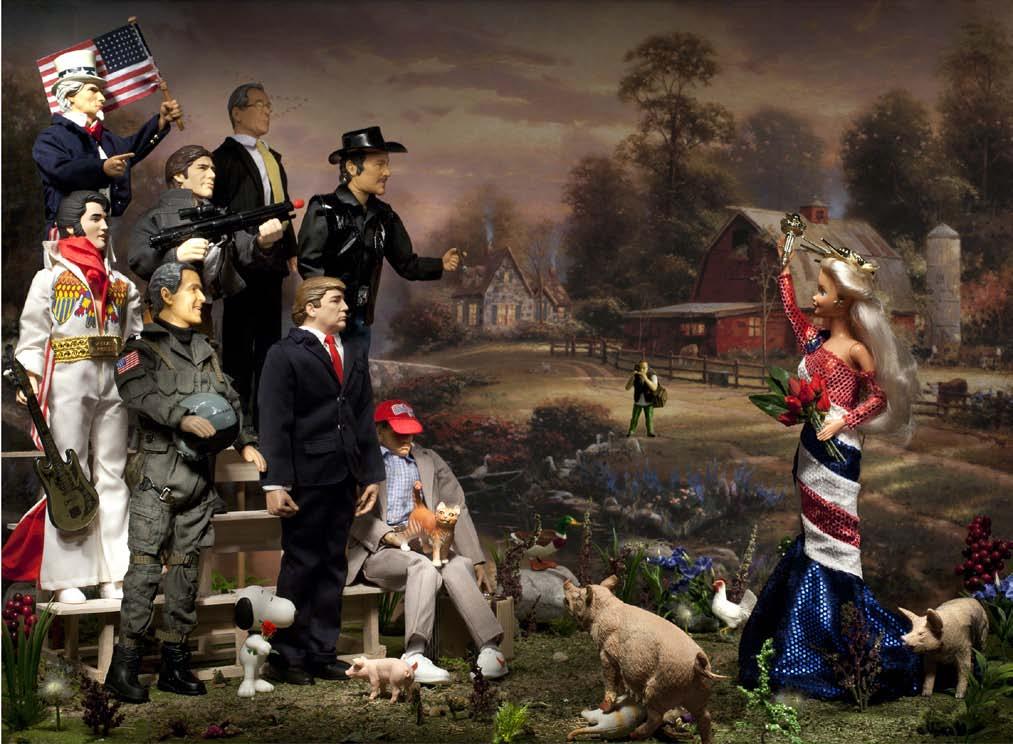
American Bachelorette (at Riverbend Farm)
Chromogenic Digital Photograph, 2013
Edition of 5 - 36 3/4 x 50 in / 93 x 127 cm
Edition of 20 - 22 x 30 in / 56 x 76 cm
of deep fried cake (supposedly the doughnut hole though in fact not), sold throughout Canada by the Tim Horton’s doughnut store chain. Waiting in anticipation are a pantheon of Canadian celebrities such as William Shatner (as Captain Kirk), hockey player Wayne Gretzky, and teen pop idol Justin Bieber, who all gained fame and broader career recognition south of the 49th parallel. Patriotic figures such as comic super hero Captain Canuck and a RCMP “Mountie” present themselves as potential objects of Anne’s affections. As with the American bachelorette, Thorneycroft holds out the queer possibility of this encounter with a female Mountie and a cast of woodland animals all seeming to audition for the role of suitor.
Thorneycroft’s group tableaux are populated with assemblies of men, performing the rituals of male bonding, expressing camaraderie over drinks, or hunting, or in the case of On the Beach (at Gilligan’s Island) ogling the golden beauty of 1970s television star Farrah Fawcett in her notorious red bathing suit. Yet these groups of familiar figures point to one of the most common complications between Canada and the United States; that is the ubiquity of Canada and Canadians within US popular culture and media. Though Canada and Canadians are seen – as locations and actors in films – the nation and its nationals are not recognized as such. Rather Vancouver passes for San Francisco and Toronto for New York just as easily as Kiefer Sutherland (the grandson of Canadian socialist Tommy Douglas) seamlessly passes for a CIA agent using torture to fight the “War on Terror.”
These assemblies of men are not without sexual tension, a dimension of masculinity that Thorneycroft foregrounds in The Swimming Hole (Michael and his Bodyguard). Her use of pop-star Michael Jackson and his Canadian bodyguard, represented by “Billy”, the anatomically endowed gay action figure, reframes American painter Thomas Eakins’ (American 1844-1916) The Swimming Hole (1885) with an explicitly queer gaze. Eakins’ late-19th century work, with its nostalgic and anti-modern
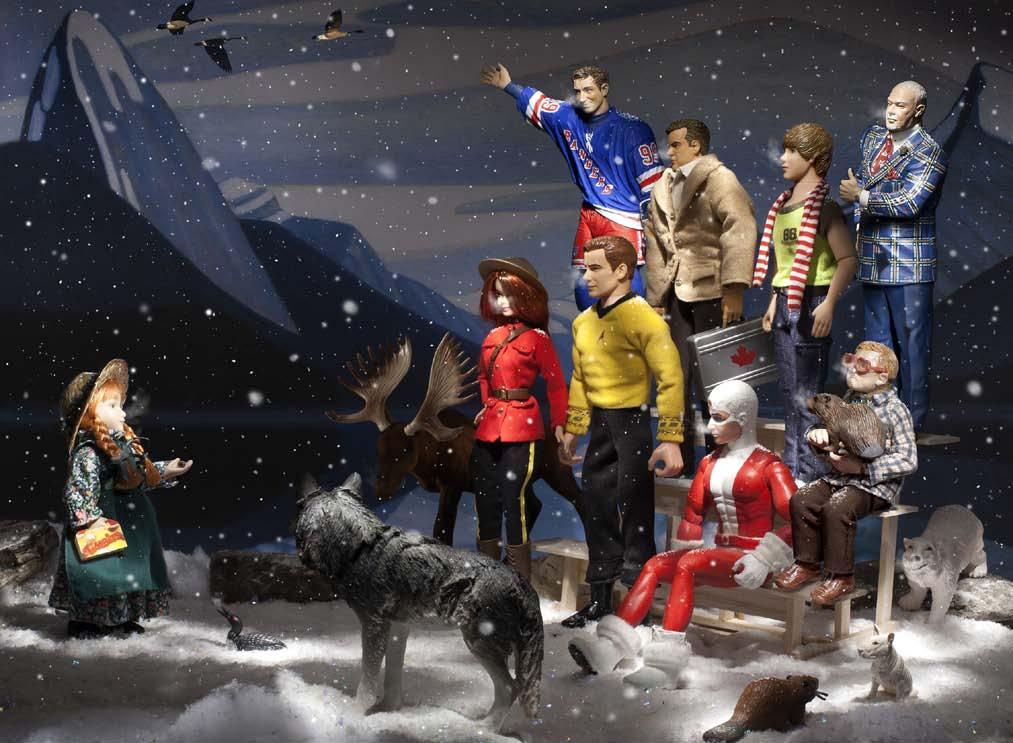
Canadian Bachelorette (at Maligne Lake, Jasper Park)
Chromogenic Digital Photograph, 2013
Edition of 5 - 36 3/4 x 50 in / 93 x 127 cm
Edition of 20 - 22 x 30 in / 56 x 76 cm
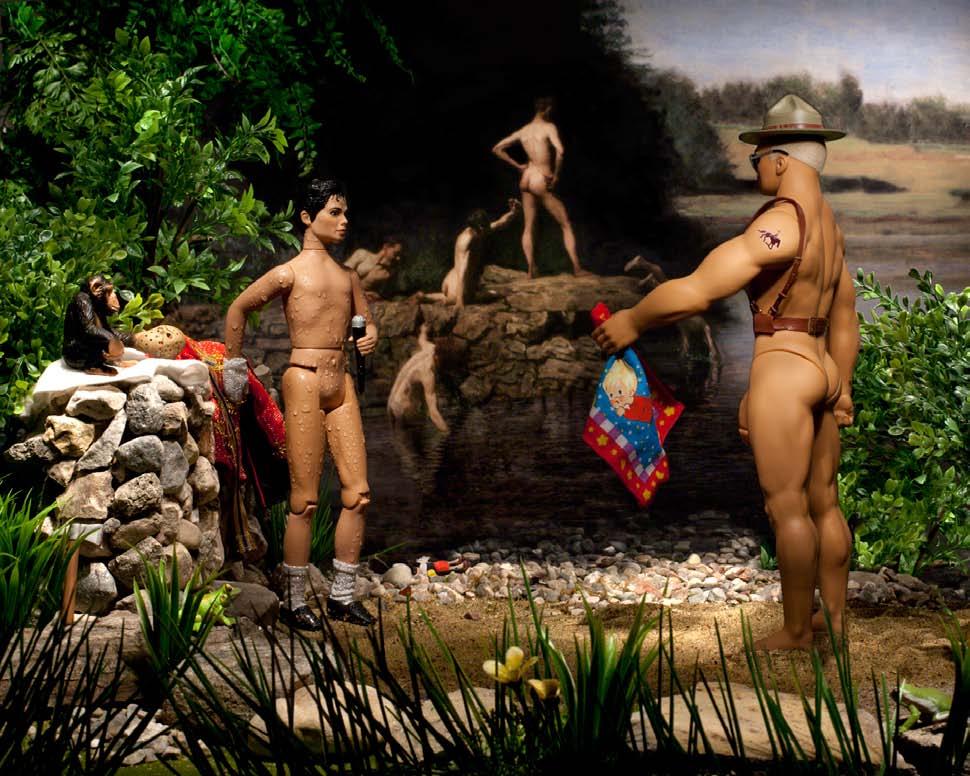
The Swimming Hole (Michael and his Bodyguard)
Chromogenic Digital Photograph, 2012
Edition of 5 - 40 x 50 in / 102 x 127 cm
Edition of 20 - 24 x 30 in / 61 x 76 cm
depiction of idealized youthful white masculinity, seems to contemporary eyes irredeemably erotic. Eakins, who used photographs as studies for his painting, produced his work at a moment of tremendous social anxiety around the feminization of men; due in part to the de-skilling of labour by technologies as well as increasingly bureaucratic and administrative forms of employment. As American men in the 19th century worked less with their hands, performing fewer physical labours, and becoming increasingly sedentary, the body itself became a site for debates about vitality and the so-called vigorous life. The great fear was of becoming soft, effeminate and unmanly – like Michael Jackson. Jackson’s androgyny was the very sort that Eakins and others were deeply worried about – underscored by the action figure Jackson’s lack of a penis. Jackson’s body is thus disruptive; it violates the idealized norm of healthy masculinity. In contrast, Billy provides the very model of a sculpted physique – a fit and vital man. Yet in spite of his large penis, Billy’s status as a gay circuit boy – places them outside any hetero-normative and pro-natalist vision of the American nation.
Militarism, firearms and masculine violence are recurrent themes that haunt many of Thorneycroft’s photographs. Though she is careful not to elide or ignore abuse, violence, misogyny and racism in her Canadian tableaux, the sheer magnitude and pervasiveness of US gun and small arms industry and its impact on the popular and public culture permeates the series. In NRA Sponsored Rhythmic Gymnastics Competition, Canada and France gaze upon the gender bending US team with their pink assault weapons. Meanwhile Rocky – the classic example of the American fantasy of itself as underdog – cheers them on in the background.
Thorneycroft’s Canada is not a utopian fantasy; the good twin opposite its evil US sibling. In Portrait of Winnipeg (Run! Forrest! Run!) a prostrate and dying Forrest Gump has discovered that life is not a box of chocolates while waiting for a bus on Winnipeg’s Portage Avenue. Instead he is the very real victim of urban violence, dis-
rupting the trite vision of Canada as safe, polite and ever so boring. Similarly, in Christina’s World (gets turned upside down by Cpl. Dew Wright) Thorneycroft disrupts the solitary contemplative figure, this time with a seemingly violent intervention by the fictional Royal Canadian Mounted Policeman from The Rocky and Bullwinkle Show, Cpl. Dudley Do-Right. It is unclear whether Thorneycroft’s Mountie is saving Christina from some unseen threat, or more troublingly engaging in an act of physical or sexual assault. This perhaps is the reality of Christina’s world, one with a very real presence of masculine violence in the guise of paternalistic protection. Canada is not a safe haven and though crime rates may be lower north of the border, Thorneycroft reminds us murder, assault and state harassment are as authentically Canadian as they are American.
Can Special Agent Jack Bauer, played by Canadian actor Kiefer Sutherland, save the briefcase of Canadian secrets from the American bald eagle? Why are the Canadian secrets more important than saving Tippi Hedren/Barbie in Thorneycroft’s mash-up of Edward Hopper’s painting Nighthawks (1942) and Director Alfred Hitchcock’s film The Birds (1963)?
To my eye, the photograph that plays most explicitly with things known and unknown, seen and unseen, is Lake O’Hara (Clark, Northern Dancer and the Evil Weasel). Here against Group of Seven artist J.E.H. MacDonald’s (Canadian 1873-1932) landscape painting Lake O’Hara (1926), Thorneycroft presents Superman astride the thoroughbred stallion Northern Dancer. With elements such as Superman’s flowing cape, equestrian theme, and mountain setting the photograph is evocative of Jacques-Louis David’s (French 1748-1825) painting Napoleon Crossing the Alps (1800), a classic image of masculine conquest and Empire. At one level Thorneycroft depicts an image of US hegemony in all its rampant cartoonish, fantasmagorical supremacy. The use of the quintessential American superhero, Superman, is tempered
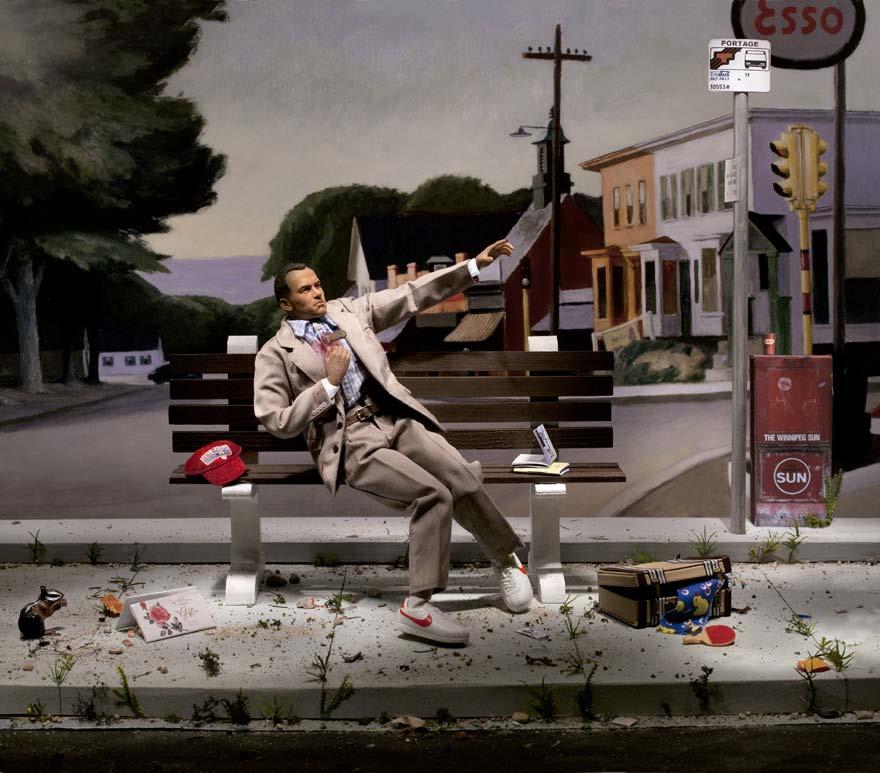
Portrait of Winnipeg (Run! Forrest! Run!)
Chromogenic Digital Photograph, 2013
Edition of 5 - 43 x 50 in / 109 x 127 cm
Edition of 20 - 26 x 30 in / 66 x 76 cm
by the fact that one of the comic book hero’s creators was the Toronto born Joe Shuster (1914-1992); a subtle reminder to the viewer that things authentically American, may in fact have foreign origins and elements. Additionally, Superman’s mount is not just any horse, but rather the Canadian-bred and owned race horse Northern Dancer, who won two legs of the US Triple crown (the Kentucky Derby and the Preakness) as well as the Canadian Queen’s Plate in 1964, and went on to become one of the most successful sires in the history of thoroughbred racing. What makes this photograph truly exceptional is its play between what is absent and ultimately what it asks of the viewer in terms of cultural awareness. In the bottom corner of the work is the “evil weasel” clutching a shard of kryptonite; the very thing that makes Superman weak and vulnerable. Just as rider and horse suggest transcendent power, strength and virility, the weasel reminds us that this scene could suddenly change.
Underscoring this trope is the action figure of Superman itself, modeled after American actor Christopher Reeve (1952-2004) who portrayed the “man of steel” in the 1978 film Superman. In 1995 Reeve was thrown from his horse during an equestrian competition, breaking his back and leaving him a quadriplegic. Ultimately, Thorneycroft gives us an enormously subtle and layered vision of the complexity of American power, one that may prove to be enormously fragile and fleeting. Rise or fall, Canadians are invariably bound up with the complicated fortunes, movements and ambitions of our BFF’s.
Dr. David S. Churchill
David S. Churchill is an Associate Professor of US History at The University of Manitoba, is CoCordinator of the Interdisciplinary Research Circle on Globalization and Cosmopolitanism, and currently holds a SSHRC Insight Grant on Homophile Internationalism.
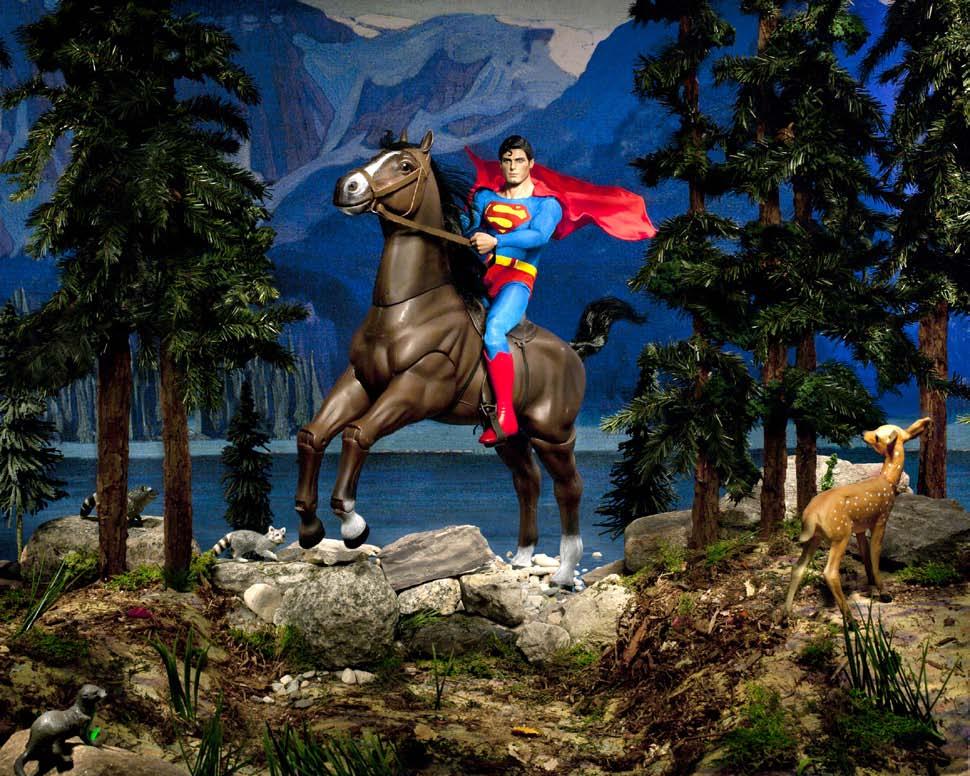
Chromogenic Digital Photograph, 2012
Edition of 5 - 40 x 50 in / 102 x 127 cm
Edition of 20 - 24 x 30 in / 61 x 76 cm

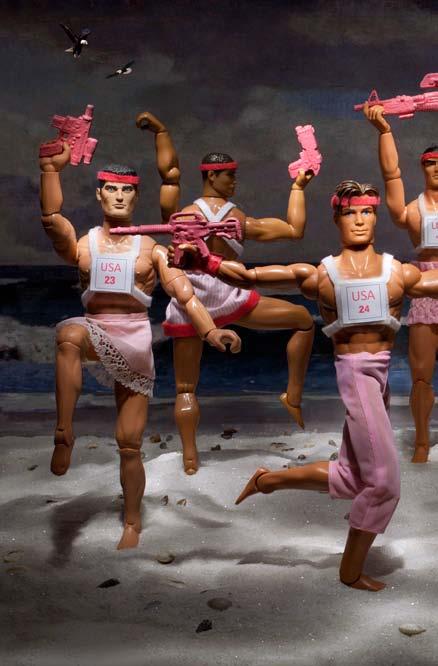
NRA Sponsored Rhythmic Gymnastics Competition (Team USA performs while Canada and France look on)
Chromogenic Digital Photograph, 2012
Edition of 5 - 30 x 30 in, 30 x 40 in, 30 x 30 in / 76 x 76 cm, 76 x 102 cm, 76 x 76 cm
Edition of 20 - 20 x 20 in, 20 x 26 1/4 in, 20 x 20 in / 51 x 51 cm, 51 x 67 cm, 51 x 51 cm
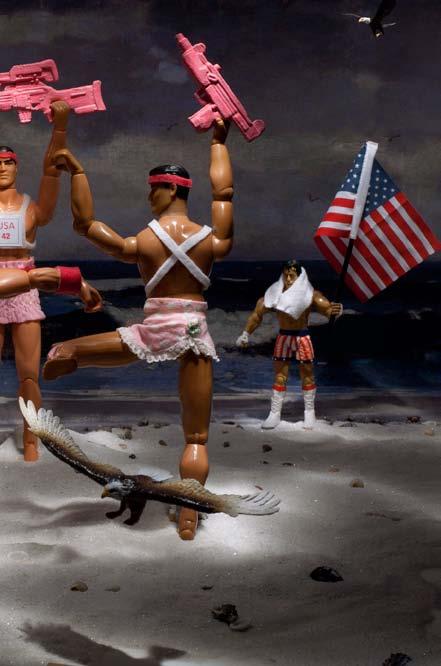
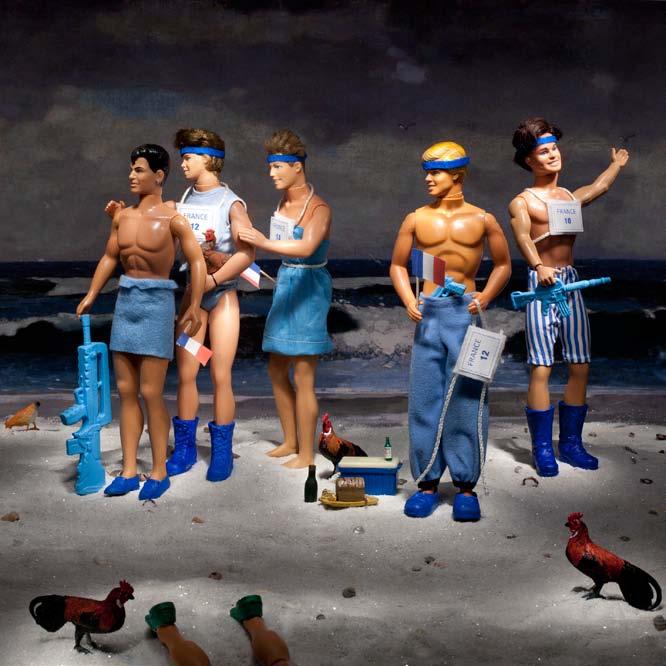
Christina’s World (gets turned upside down by Cpl. Dew Wright)
Chromogenic Digital Photograph, 2012
Edition of 5 - 35 x 50 in / 89 x 127 cm
Edition of 20 - 21 x 30 in / 53 x 76 cm
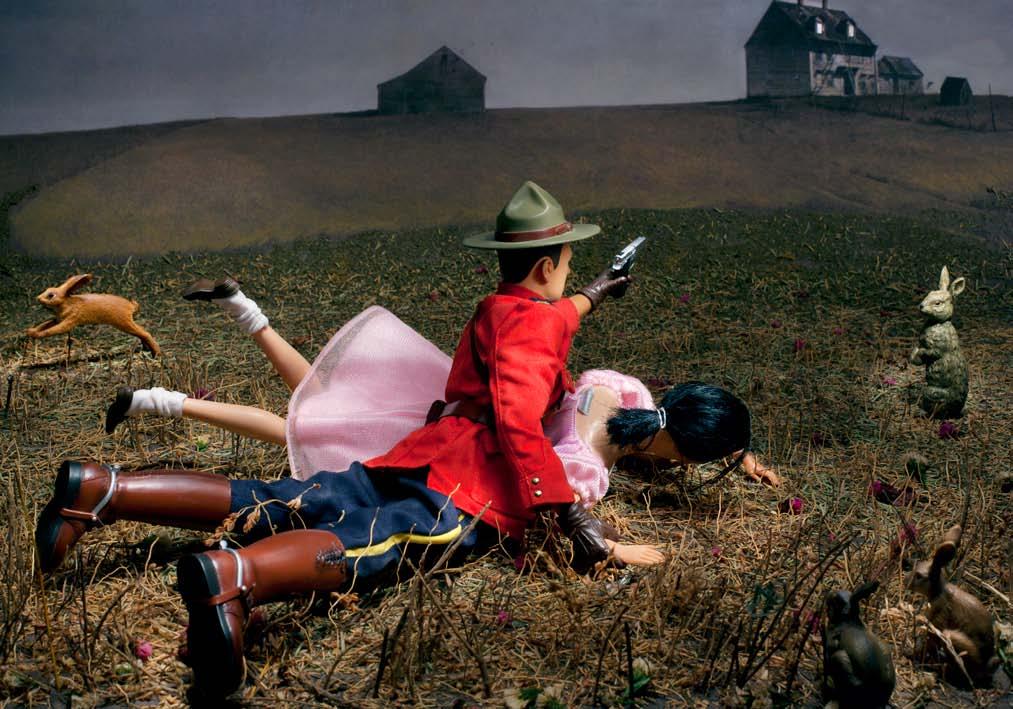
Chromogenic Digital Photograph, 2012
Edition of 5 - 38 1/4 x 50 in / 97 x 127 cm
Edition of 20 - 23 x 30 in / 58 x 76 cm
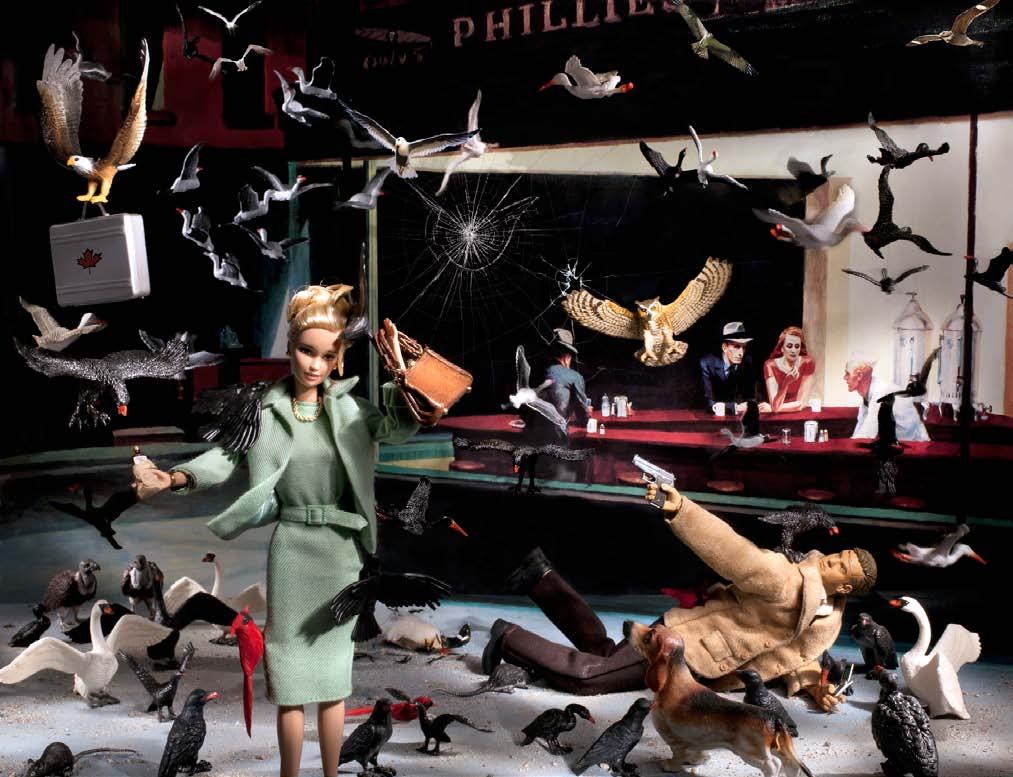
Boys (Believing the myth of Canadian beer)
Chromogenic Digital Photograph, 2013
Edition of 5 - 36 3/4 x 50 in / 93 x 127 cm
Edition of 20 - 22 x 30 in / 56 x 76 cm
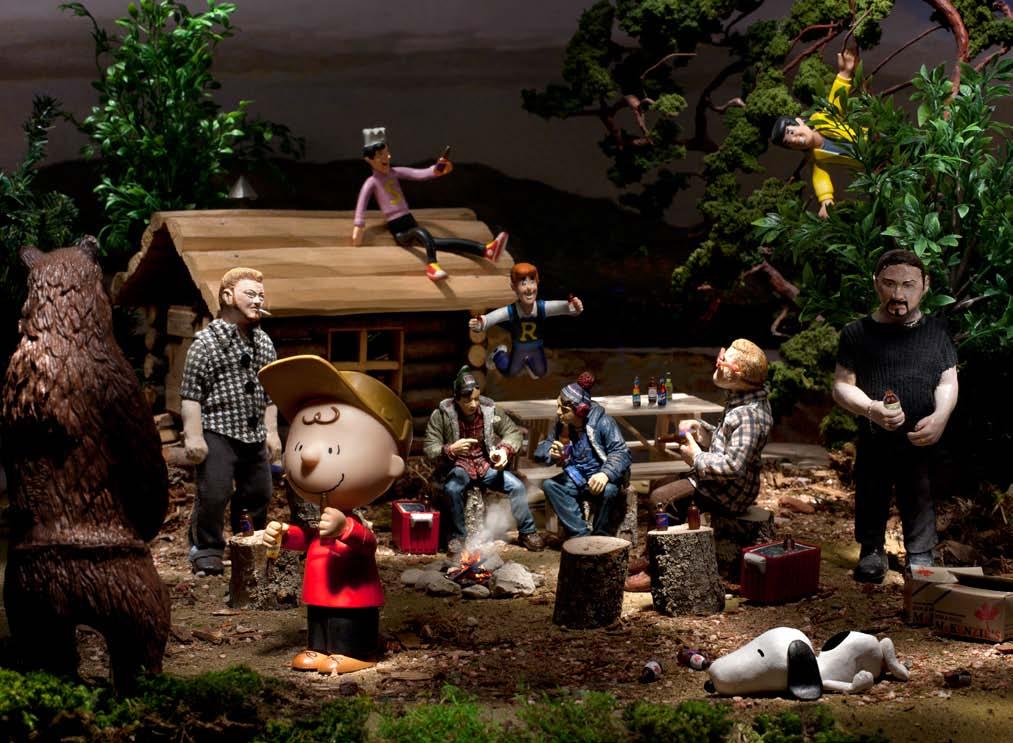
Chromogenic Digital Photograph, 2012
Edition of 5 - 36 3/4 x 50 in / 93 x 127 cm
Edition of 20 - 22 x 30 in / 56 x 76 cm
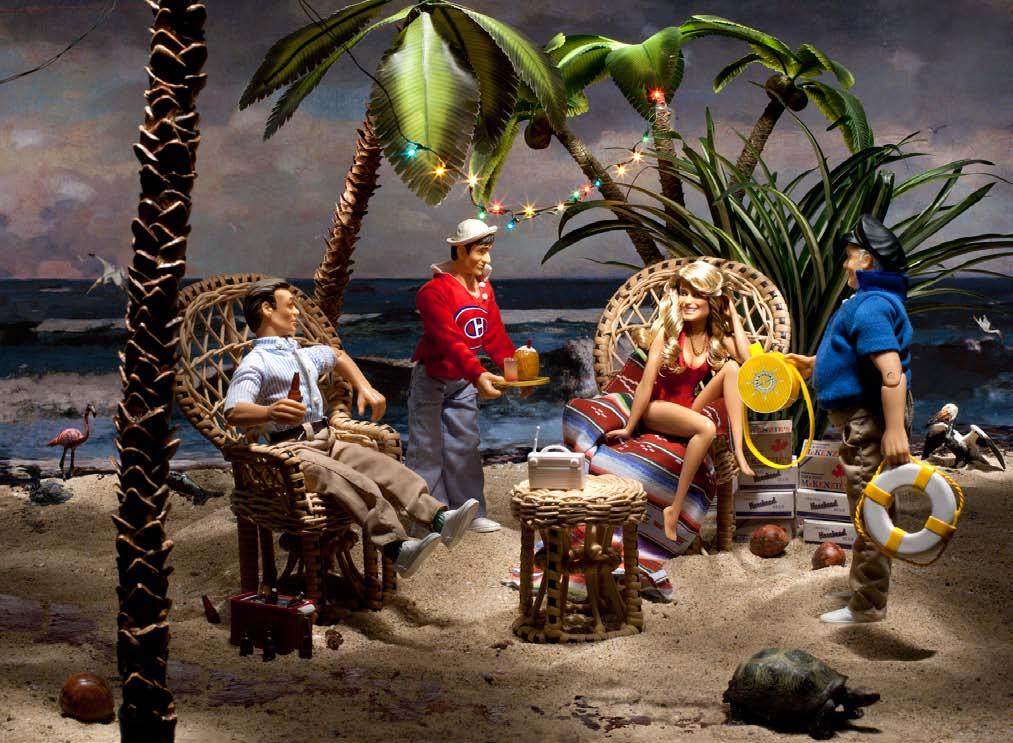
Winter Birches (This is my brother Bubba and my other brother Bubba)
Chromogenic Digital Photograph, 2013
Edition of 5 - 36 3/4 x 50 in / 93 x 127 cm
Edition of 20 - 22 x 30 in / 56 x 76 cm
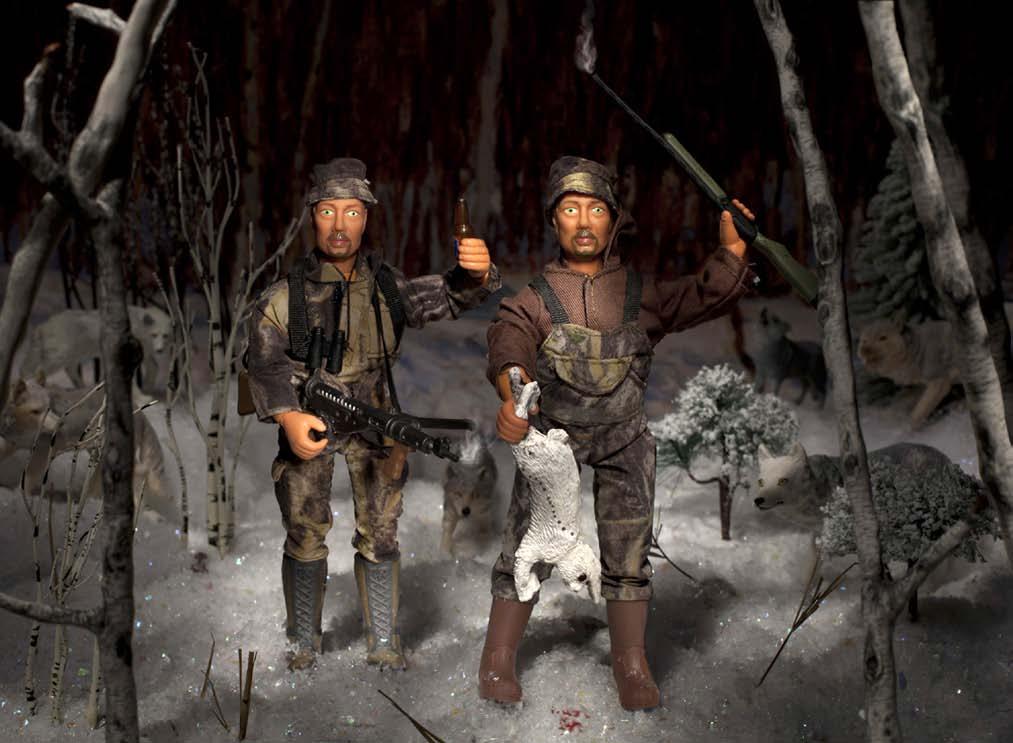
Portrait of Winnipeg (Life is like a box of chocolates)
Chromogenic Digital Photograph, 2013
Edition of 5 - 40 x 50 in / 102 x 127 cm
Edition of 20 - 24 x 30 in / 61 x 76 cm
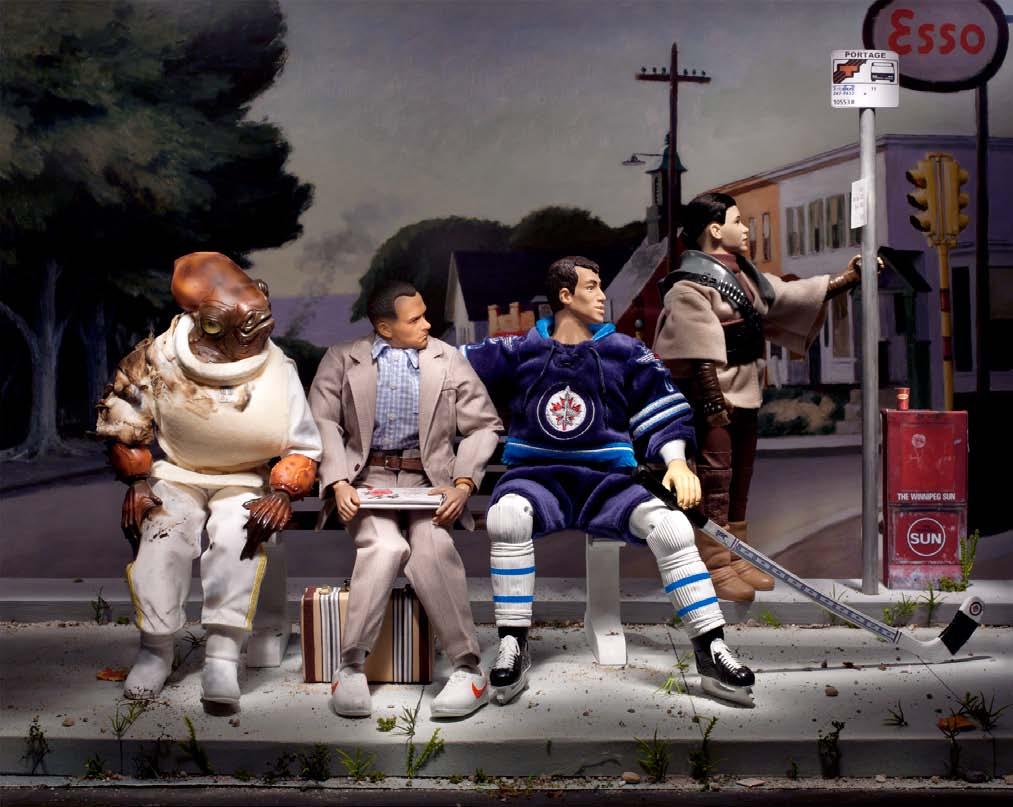
The Bob Hope Christmas Special at Guantanamo Bay (starring Liberace, Justin Bieber and Miss Nude Maple Leaf)
Chromogenic Digital Photograph, 2013
Edition of 5 - 36 3/4 x 50 in / 93 x 127 cm
Edition of 20 - 22 x 30 in / 56 x 76 cm

In 2012 I was awarded a Manitoba Arts Council Major Arts Grant and an Individual Artist Grant from the Winnipeg Arts Council to take my work in a new direction. The plan was to turn my focus southward, to the United States of America, and to make a suite of photographs that explored and exploited this wonderful, aggravating, generous and complex country. Simply put, I was going to “do to Americans” the same thing I had done to Canadians in my Group of Seven Awkward Moments. As someone who grew up in the 60’s, I was going to subvert the content I had been exposed to as a child/teenager/young adult: the Kennedy assassination, the Apollo space program, the sobering realization that the KKK still exists, the Vietnam War, Watergate, and the NRA.
The original template was similar to my earlier work; use famous American landscapes as backdrops and American action figures to provide the narrative.
When I began working on Canadians and Americans (best friends forever...it’s complicated), I was pleased with the first couple of images I produced as they related to two American icons familiar to us all: Marilyn Monroe and Clint Eastwood. After that though, much to my surprise, things didn’t go well. I tried making photographs about other iconic personalities like Elvis and Charlie Brown, but they failed.
I was perplexed. I believed I knew American culture. Its presence in my daily life is invasive and ubiquitous. After several months of unsuccessful image making I realized I had to bring something of my own identity as a Canadian back into the work about Americans. I needed to address what it’s like living next to a country that barely acknowledges our existence. I needed to insert my version of a subversive Canadian
element into the images that I was intending to critique.
The underlying impetus with this work is to examine the unbalanced power dynamic that exist in relationships. Canadians and Americans (best friends forever...it’s complicated) acknowledges that, like it or not, we are best friends forever. In order to make these photographs I worked within the monolith that is American culture, and at the same time, stood apart from it, critically looking in from the outside.
In each of the photographs I have completed in the last two years, traces of “Canadiana” have infiltrated an otherwise American narrative. Michael Jackson has a Canadian body guard, the Professor from Gilligan’s Island drinks a stubby, Jack Bauer (aka Kiefer Sutherland) has a briefcase full of Canadian secrets and Christina gets tackled by an over zealous RCMP officer. All the photographs in this new series continue to express my attraction to the absurd and inclination toward black humour. Chronological time and logic are irrelevant.
Diana Thorneycroft in her Winnipeg studio Spring 2013
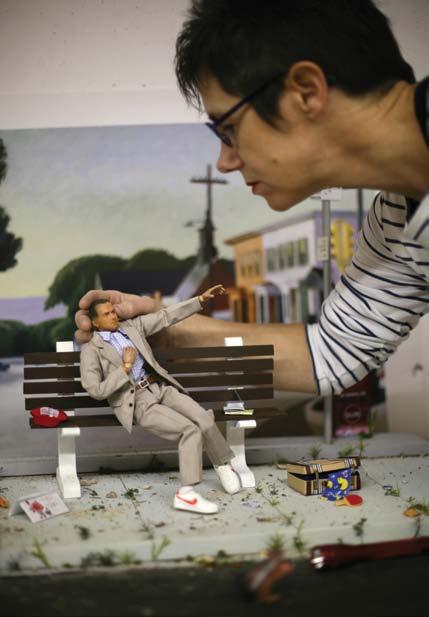
Diana Thorneycroft was born on a military base in Claresholm, Alberta. Because her father was a pilot in the Canadian Armed Forces, she and her family moved, on average, every three years, to bases and towns associated with the airforce. As an adult, she eventually settled in Winnipeg, Manitoba. In 1979 she received her BFA from the University of Manitoba in Winnipeg and graduated the following year with a MA from the University of Wisconsin in Madison, Wisconsin.
For over three decades Thorneycroft’s artistic practice has included drawing, printmaking, sculpture, set constructions and photography. Since the 1990s, she has produced a body of work that is organized into a number of series that deal with the human body as a social, political, and gendered space of interrogation, as well as a variety of other issues such as violence, human anxiety and national identity.
Thorneycroft has had solo shows and has participated in group exhibitions both nationally and internationally. Most recently her Group of Seven Awkward Moments series has been exhibited extensively across Canada including shows at the McMichael Canadian Art Collection, the Winnipeg Art Gallery, Carleton University and at the Canadian Cultural Centre in Paris, France. In 2008 Canadian Art Magazine listed the Group of Seven Awkward Moments as one of the best exhibitions in Canada of 2008.
In addition to her work being the subject of national radio and CBC TV documentaries, her photography was included in the 2002 Phaidon publication “Blink”, which presented the work of 100 rising stars in photography.
Diana Thorneycroft is in numerous private and public collections including the Vancouver Art Gallery, Winnipeg Art Gallery, McMichael Canadian Art Collection and the Canadian Museum of Contemporary Photography.
Canadians and Americans (best friends forever...it’s complicated)
Catalogue of an exhibition held at Michael Gibson Gallery October 3 - 26, 2013
Thank you to Dr. David Churchill for his insightful essay on Diana Thorneycroft’s work
Michael Gibson Gallery gratefully acknowledges the assistance of the Canada Council for the Arts

Diana Thorneycroft thanks the Winnipeg Arts Council and the Manitoba Arts Council for their support


For Diana Thorneycroft’s complete Curriculum Vitae please visit www.gibsongallery.com
Front Cover Image: detail of Lake O’Hara (Clark, Northern Dancer and the Evil Weasel)
Back Cover Image: detail of The Battle of Queenston Heights (War of 1812)
Images © Diana Thorneycroft
ISBN 978-0-9736461-7-7
Design Michael Gibson Gallery
Printed Carter’s Printing Inc., London, ON
